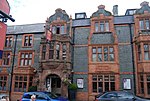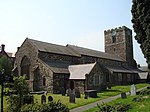Conwy railway station
Beeching closures in WalesBuildings and structures in ConwyDfT Category F2 stationsFormer London and North Western Railway stationsRailway request stops in Great Britain ... and 7 more
Railway stations in Conwy County BoroughRailway stations in Great Britain closed in 1966Railway stations in Great Britain opened in 1848Railway stations in Great Britain opened in 1987Railway stations served by Transport for Wales RailReopened railway stations in Great BritainUse British English from November 2013

Conwy railway station serves the town of Conwy, north Wales, and is located on the North Wales Main Line, between Crewe and Holyhead. It is served by Transport for Wales, on services from Holyhead to South Wales and Birmingham International.
Excerpt from the Wikipedia article Conwy railway station (License: CC BY-SA 3.0, Authors, Images).Conwy railway station
Rosemary Lane,
Geographical coordinates (GPS) Address Nearby Places Show on map
Geographical coordinates (GPS)
| Latitude | Longitude |
|---|---|
| N 53.28 ° | E -3.831 ° |
Address
Conwy Secondary Social Inclusion Services
Rosemary Lane
LL32 8LB
Wales, United Kingdom
Open on Google Maps









